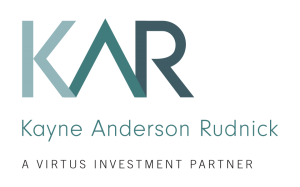Virtus Tactical Allocation Fund
Virtus Tactical Allocation Fund
Investment Overview
The Fund seeks to achieve both capital appreciation and current income through a diversified portfolio of global stocks and fixed income securities. Disciplined fundamental analysis is employed to construct a diversified portfolio typically allocated to U.S. equity (25%-60%), non-U.S. equity (5%-30%), and fixed income (35%-60%).
Investment Partners
Kayne Anderson Rudnick Investment Management, LLC
Founded in 1984, Kayne Anderson Rudnick (KAR) manages quality-focused equity strategies across investment styles, market caps, and geographies. KAR believes that strong risk-adjusted returns may be achieved through investment in high-quality companies with market dominance, excellent management, financial strength, and consistent growth, purchased at reasonable prices.
Learn more about Kayne Anderson Rudnick Investment Management, LLC
Newfleet Asset Management
Newfleet Asset Management is a multi-sector fixed income manager with more than a quarter century of experience investing across the full fixed income universe.
Newfleet leverages the knowledge and skill of a team of investment professionals with expertise in every sector of the bond market, including evolving, specialized, and out-of-favor sectors. The team employs active sector rotation and disciplined risk management to construct diversified portfolios.
Newfleet Asset Management is a division of Virtus Fixed Income Advisers, LLC ('VFIA'), an SEC registered investment adviser.
Learn more about Newfleet Asset Management
Investment Professionals

David L. Albrycht, CFA
President and Chief Investment Officer
Industry start date: 1985
Start date as fund Portfolio Manager: 2011

Craig Thrasher, CFA
Portfolio Manager and Senior Research Analyst
Industry start date: 2003
Start date as fund Portfolio Manager: 2019

Hyung Kim
Portfolio Manager and Senior Research Analyst
Industry start date: 2004
Start date as fund Portfolio Manager: 2019

Chris Armbruster, CFA
Portfolio Manager and Senior Research Analyst
Industry start date: 2004
Start date as fund Portfolio Manager: 2020

Stephen H. Hooker, CFA
Managing Director and Portfolio Manager
Industry start date: 1993
Start date as fund Portfolio Manager: 2020

Noran Eid, CFA
Portfolio Manager and Senior Research Analyst
Industry start date: 2006
Start date as fund Portfolio Manager: 2023
Key Features
Actively Balances Risk and Reward
Leverages diverse investment expertise from across Virtus to deliver a portfolio that adjusts underlying allocations as warranted based on changing market conditions
Global Equity Exposure
Extensive fundamental research guides discrete, actively managed investment styles in the U.S. equity and international equity allocations
Multi-Sector Fixed Income Exposure
Employs a time-tested approach of active sector rotation, extensive credit research, and disciplined risk management
Top Holdings (% Fund)
| Security | |
|---|---|
| NVIDIA Corp | |
| Amazon.com Inc | |
| Visa Inc | |
| Meta Platforms Inc | |
| Amphenol Corp | |
| Fair Isaac Corp | |
| Eli Lilly & Co | |
| Trade Desk Inc/The | |
| Baltic Classifieds Group PLC | |
| Uber Technologies Inc |
Holdings are subject to change.
Characteristics4
(as of 06/28/2024)| Average Weighted Market Cap (billions) | $458.94 |
| Median Market Cap (billions) | $29.97 |
| Trailing P/E Ex-Negative Earnings | 31.30 |
| Price-to-Cash Flow | 24.74 |
| Price-to-Book Value | 6.28 |
| 3-Year Earnings Growth Rate | 15.31 |
Sector Allocation (% Equity)
| Information Technology | |
| Consumer Discretionary | |
| Communication Services | |
| Financials | |
| Industrials | |
| Health Care | |
| Consumer Staples | |
| Materials | |
| Real Estate | |
| Energy |
Growth of $10,000 Investment
From toPerformance
Performance data quoted represents past results. Past performance is no guarantee of future results and current performance may be higher or lower than the performance shown. Investment return and principal value will fluctuate, so your shares, when redeemed, may be worth more or less than their original cost.
Sales Charge and Expenses
The Index shown represents the Fund's performance index, which may differ from the Fund's regulatory index included in the Fund's Prospectus.
Distribution History2
| Ex-Date | |
| Income | |
| STCG | |
| LTCG | |
| Reinvest NAV |
Risk Statistics3
(as of )| Fund | Index | |
|---|---|---|
| R2 | ||
| Beta | ||
| Alpha | ||
| Std Dev |
Risk Considerations
Investors should carefully consider the investment objectives, risks, charges and expenses of any Virtus Mutual Fund before investing. The prospectus and summary prospectus contains this and other information about the fund. Please contact your financial representative, call 1-800-243-4361 to obtain a current prospectus and/or summary prospectus. You should read the prospectus and/or summary prospectus carefully before you invest or send money.
Performance data quoted represents past results. Past performance is no guarantee of future results and current performance may be higher or lower than the performance shown. Investment return and principal value will fluctuate, so your shares, when redeemed, may be worth more or less than their original cost.
Average annual total return is the annual compound return for the indicated period. It reflects the change in share price and the reinvestment of all dividends and capital gains. NAV returns do not include the effect of any applicable sales charges. POP and w/CDSC returns include the effect of maximum applicable sales charges.
Returns for periods of less than one year are cumulative total returns.
1 Yields/Distributions: 30-day SEC Yield is a standardized yield calculated according to a formula set by the SEC, and is subject to change. 30-day SEC Yield (unsubsidized) is the 30-day SEC Yield without the effect of applicable expense waivers. Distribution Rate is calculated by (a) annualizing the latest income distribution for fixed income funds or funds less than 1 year old, or (b) summing all income distributions over the preceding 12 months for all other funds, and dividing the NAV on the last business date of the period, unless otherwise indicated. The Distribution Rate may be comprised of ordinary income, net realized capital gains and returns of capital.
2 Distribution History: Distributions are represented on a cash basis and may be reclassified at year end for tax purposes. The Fund will send you a Form 1099-DIV for the calendar year that will tell you how to report these distributions for federal income tax purposes. STCG: Short Term Capital Gain, LTCG: Long Term Capital Gain
3 Risk Statistics: R2 is a statistical measure that represents the percentage of a fund or security's movements that can be explained by movements in a benchmark index. Beta is a quantitative measure of the volatility of a given portfolio to the overall market. Alpha is a risk adjusted measure of an investment's excess return relative to a benchmark. A positive Alpha indicates that the investment produced a return greater than expected for the risk (as measured by Beta) taken. Standard Deviation measures variability of returns around the average return for an investment fund. Higher standard deviation suggests greater risk. Risk Statistics are calculated using 36 monthly returns.
4 Characteristics: For Equity Funds: Avg. Weighted Market Cap (bn): The sum of each security's weight within the fund (or index) multiplied by the security's market capitalization; Trailing P/E Ex-Negative Earnings: Per-share stock price divided by the latest 12-months Earnings per Share; Price/Cash Flow: Per-share stock price divided by the per-share operating cash flow; Price/Book: Per-share stock price divided by the latest 12-month per-share Book Value; 3-Year EPS Growth Rate: Average of earnings per share growth for latest 3-year period. The 3-Year EPS Growth Rate is not a forecast of the fund's performance.
4 Characteristics: For Fixed Income Funds: Effective Duration represents the interest rate sensitivity of a fixed income fund. For example, if a fund's effective duration is five years, a 1% increase in interest rates would result in a 5% decline in the fund's price. Similarly, a 1% decline in interest rates would result in a 5% gain in the fund's price.
Morningstar Disclosures:
The Morningstar Rating™ for funds, or "star rating", is calculated for managed products (including mutual funds, variable annuity and variable life subaccounts, exchange-traded funds, closed-end funds, and separate accounts) with at least a three-year history. Exchange-traded funds and open-ended mutual funds are considered a single population for comparative purposes. It is calculated based on a Morningstar Risk-Adjusted Return measure that accounts for variation in a managed product's monthly excess performance, placing more emphasis on downward variations and rewarding consistent performance. The top 10% of products in each product category receive 5 stars, the next 22.5% receive 4 stars, the next 35% receive 3 stars, the next 22.5% receive 2 stars, and the bottom 10% receive 1 star. The Overall Morningstar Rating for a managed product is derived from a weighted average of the performance figures associated with its three-, five-, and 10-year (if applicable) Morningstar Rating metrics. The weights are: 100% three-year rating for 36-59 months of total returns, 60% five-year rating/40% three-year rating for 60-119 months of total returns, and 50% 10-year rating/30% five-year rating/20% three-year rating for 120 or more months of total returns. While the 10-year overall star rating formula seems to give the most weight to the 10-year period, the most recent three-year period actually has the greatest impact because it is included in all three rating periods. Ratings do not take into account the effects of sales charges and loads.
© 2024 Morningstar, Inc. All rights reserved. The information contained herein: (1) is proprietary to Morningstar and/or its content providers; (2) may not be copied or distributed; and (3) is not warranted to be accurate, complete, or timely. Neither Morningstar nor its content providers are responsible for any damages or losses arising from any use of this information. Past performance is no guarantee of future results.

